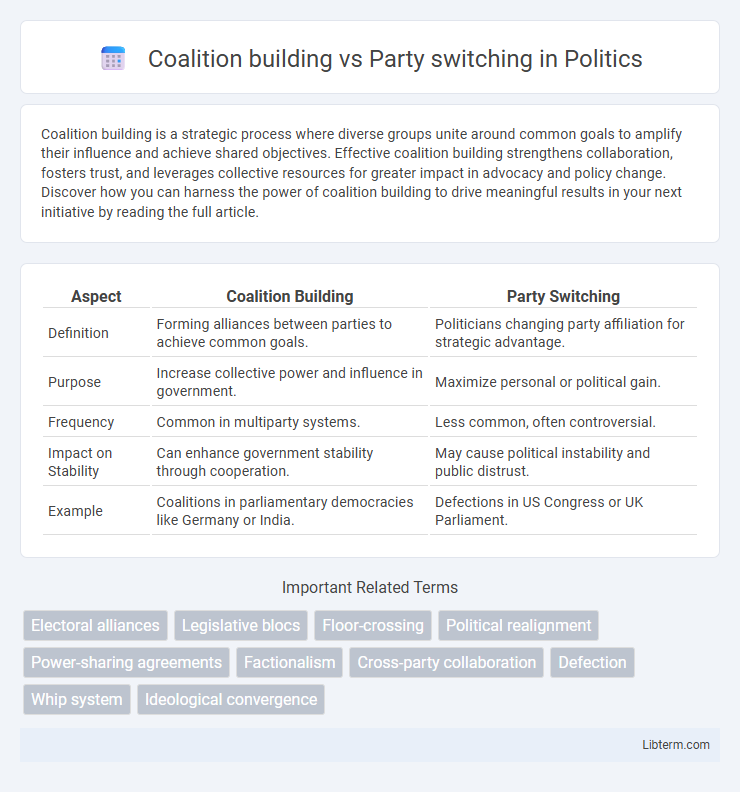Coalition building is a strategic process where diverse groups unite around common goals to amplify their influence and achieve shared objectives. Effective coalition building strengthens collaboration, fosters trust, and leverages collective resources for greater impact in advocacy and policy change. Discover how you can harness the power of coalition building to drive meaningful results in your next initiative by reading the full article.
Table of Comparison
| Aspect | Coalition Building | Party Switching |
|---|---|---|
| Definition | Forming alliances between parties to achieve common goals. | Politicians changing party affiliation for strategic advantage. |
| Purpose | Increase collective power and influence in government. | Maximize personal or political gain. |
| Frequency | Common in multiparty systems. | Less common, often controversial. |
| Impact on Stability | Can enhance government stability through cooperation. | May cause political instability and public distrust. |
| Example | Coalitions in parliamentary democracies like Germany or India. | Defections in US Congress or UK Parliament. |
Understanding Coalition Building
Coalition building involves multiple political parties or groups forming alliances to achieve common policy goals or maintain governance stability, often requiring negotiation and compromise among diverse interests. This strategy enhances legislative effectiveness by pooling resources and votes, enabling broader representation and increased political influence. Unlike party switching, which entails an individual politician changing party affiliation for personal or strategic reasons, coalition building emphasizes collective cooperation without altering party identities.
Defining Party Switching
Party switching refers to the act of politicians changing their party affiliation during their term in office. Unlike coalition building, which involves forming alliances between multiple parties to achieve common goals, party switching directly alters the political landscape by shifting individual loyalty and affecting party strength. This phenomenon can influence legislative dynamics, electoral outcomes, and party system stability.
Key Motivations Behind Coalition Building
Key motivations behind coalition building include achieving collective policy goals, increasing political influence, and securing electoral advantages by uniting diverse parties or interest groups. Coalition building facilitates resource sharing and strategic alliances that amplify bargaining power in legislative processes. This approach contrasts with party switching, which primarily serves individual career advancement or ideological realignment rather than broad-based strategic collaboration.
Why Politicians Switch Parties
Politicians switch parties primarily to align with ideological shifts, improve electoral prospects, or gain access to greater resources and influence within a new party framework. Party switching often occurs when internal party conflicts or policy disagreements make cooperation within the original party untenable. Coalition building, by contrast, enables politicians to maintain party affiliation while forming strategic alliances to enhance legislative effectiveness and policy impact.
Impact on Political Stability
Coalition building fosters political stability by encouraging collaboration among multiple parties, resulting in more inclusive and representative governance that accommodates diverse interests. Party switching often undermines political stability, as it can lead to unpredictable shifts in power dynamics, erode voter trust, and cause governmental fragmentation or collapse. Empirical studies indicate that stable democracies tend to rely on coalition governments rather than frequent party defections, highlighting the importance of institutional frameworks that promote coalition-building mechanisms.
Voter Perception: Coalitions vs. Party Switching
Voter perception of coalition building tends to emphasize strategic collaboration and unity among parties sharing common goals, often viewed as a commitment to collective stability and policy coherence. In contrast, party switching is frequently perceived as opportunistic or driven by personal gain, leading to voter skepticism regarding the politician's loyalty and consistency. Electoral studies indicate that coalitions generally bolster voter confidence in political alignment, whereas party switching can erode trust and reduce individual candidate support.
Strategic Advantages and Risks
Coalition building enables political entities to pool resources and voter bases, enhancing legislative influence and policy impact, yet risks ideological dilution and internal conflict. Party switching offers individuals strategic realignment with prevailing political currents, potentially increasing personal power and office security but can harm credibility and voter trust. Both strategies carry risks of political instability and shifting loyalties that may disrupt governance and long-term planning.
Historical Examples: Coalition Building
Historical examples of coalition building include the post-World War II formation of the United Nations and the establishment of the European Union, both of which aimed to foster international cooperation and peace through multilateral alliances. In parliamentary systems, India's Janata Party coalition in 1977 successfully united diverse political groups to overthrow the longstanding Congress dominance. These instances demonstrate coalition building as a strategic approach to unify fragmented political landscapes and achieve shared objectives without dissolving individual party identities.
Notable Cases of Party Switching
Notable cases of party switching include Winston Churchill's move from the Conservative Party to the Liberals and back, reflecting strategic realignments in British politics. Arlen Specter's shift from Republican to Democrat in the U.S. Senate highlights ideological adaptation and electoral considerations influencing party affiliation. Such instances contrast coalition building, where multiple parties collaborate temporarily without altering individual party membership, emphasizing the distinct dynamics and motivations behind party switching.
Future Trends in Political Realignment
Future trends in political realignment indicate increased coalition building as diverse interest groups seek strategic alliances to influence policy and voter bases more effectively. Party switching is expected to decline as ideological polarization deepens, making elected officials more likely to consolidate their standing within established parties rather than shift affiliations. Advances in data analytics and social media platforms facilitate these coalitions by enabling targeted outreach and mobilization across fragmented political landscapes.
Coalition building Infographic

 libterm.com
libterm.com